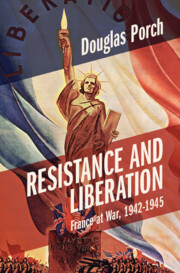Book contents
- Resistance and Liberation
- Armies of the Second World War
- Resistance and Liberation
- Copyright page
- Contents
- Figures
- Maps
- Preface
- Abbreviations
- 1 Tunisia
- 2 “A Sort of Resurrection of France”
- 3 Triumph and Dishonor in Italy
- 4 Resistance on the Eve of D-Day
- 5 “The Supreme Battle”
- 6 Anvil/Dragoon
- 7 L’amalgame
- 8 Les Vosges
- 9 Rhine and Danube
- 10 Conclusion
- Notes
- Bibliography
- Index
3 - Triumph and Dishonor in Italy
Published online by Cambridge University Press: 05 January 2024
- Resistance and Liberation
- Armies of the Second World War
- Resistance and Liberation
- Copyright page
- Contents
- Figures
- Maps
- Preface
- Abbreviations
- 1 Tunisia
- 2 “A Sort of Resurrection of France”
- 3 Triumph and Dishonor in Italy
- 4 Resistance on the Eve of D-Day
- 5 “The Supreme Battle”
- 6 Anvil/Dragoon
- 7 L’amalgame
- 8 Les Vosges
- 9 Rhine and Danube
- 10 Conclusion
- Notes
- Bibliography
- Index
Summary
Anfa had set French rearmament at eleven army divisions on a US model, as well as a French air force, and a refurbished French navy, all of which would prove difficult to accomplish with purely imperial manpower, so that a growing resistance on the French mainland might fill the manpower gap and bolster French clout in the alliance. This concept received a trial run with the September 1943 liberation of Corsica, a campaign which allowed de Gaulle to oust Giraud from the CFLN, while revealing both the military ineffectiveness of the resistance and the political agenda of the communists. As a consequence, de Gaulle began to put a structure in place to control events upon liberation of the hexagon, while beginning a purge of former Vichy elements in AFN, a task that would prove divisive in the middle of a war. The benefits of the Italian campaign for the French were two. First, the removal of much of l’armée d’Afrique from AFN allowed de Gaulle’s consolidation of power there. Second, the Juin-orchestrated May 1944 breakthrough at Monte Cassino allowed l’armée d’Afrique to recover its combat laurels in a very tough military environment. Unfortunately, the rapes carried out by some members of the CEF following the breakthrough on the Garigliano called into question the command climate and tacit complicity of the CEF hierarchy, while the fallout momentarily poisoned relations between the French and Italian governments.
- Type
- Chapter
- Information
- Resistance and LiberationFrance at War, 1942-1945, pp. 161 - 242Publisher: Cambridge University PressPrint publication year: 2024

